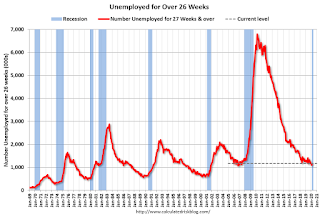by Calculated Risk on 4/03/2020 11:11:00 AM
Friday, April 03, 2020
Comments on March Employment Report
The March report was much worse than expected (due to uncertainty about the timing of layoffs), but the report is already "stale". The April report will be much worse with job losses in the millions (The April report will show the most job losses ever).
The headline number for March was 701 thousand jobs lost, and the previous two months were revised down 57 thousand, combined. The unemployment rate increased to 4.4%. The BLS noted many issues with the employment report this month (see Frequently asked questions: The impact of the coronavirus (COVID-19) pandemic on The Employment Situation for March 2020) and it appears the unemployment rate might be a percentage point higher (but that will seem like a small error next month).
Earlier: March Employment Report: 701,000 Jobs Lost (718,000 Lost ex-Census), 4.4% Unemployment Rate
In March, the year-over-year employment change was 1.504 million jobs including Census hires. The year-over-year change will turn negative next month.
"Scariest Job Chart Ever"
During the Great Recession, I posted a graph each month comparing the percentage job losses to previous recessions. This became known as the "scariest job chart".

Here is an updated version of the scariest chart. The 2020 Sudden Stop is in Red (just one month) - next month will be stunning.
The Great Recession is in blue. What made the 2007 recession so scary, was both the depth and duration of the job losses.
The 2020 recession will have the sharpest decline in jobs, but we don't know about the duration of the losses. Duration will depend on the battle against the virus.
Average Hourly Earnings
Wage growth was at expectations. From the BLS:
"In March, average hourly earnings for all employees on private nonfarm payrolls increased by 11 cents to $28.62. Over the past 12 months, average hourly earnings have increased by 3.1 percent."
 This graph is based on “Average Hourly Earnings” from the Current Employment Statistics (CES) (aka "Establishment") monthly employment report. Note: There are also two quarterly sources for earnings data: 1) “Hourly Compensation,” from the BLS’s Productivity and Costs; and 2) the Employment Cost Index which includes wage/salary and benefit compensation.
This graph is based on “Average Hourly Earnings” from the Current Employment Statistics (CES) (aka "Establishment") monthly employment report. Note: There are also two quarterly sources for earnings data: 1) “Hourly Compensation,” from the BLS’s Productivity and Costs; and 2) the Employment Cost Index which includes wage/salary and benefit compensation.The graph shows the nominal year-over-year change in "Average Hourly Earnings" for all private employees. Nominal wage growth was at 3.1% YoY in March.
Prime (25 to 54 Years Old) Participation
 Since the overall participation rate has declined due to cyclical (recession) and demographic (aging population, younger people staying in school) reasons, here is the employment-population ratio for the key working age group: 25 to 54 years old.
Since the overall participation rate has declined due to cyclical (recession) and demographic (aging population, younger people staying in school) reasons, here is the employment-population ratio for the key working age group: 25 to 54 years old.In the earlier period the participation rate for this group was trending up as women joined the labor force. Since the early '90s, the participation rate moved more sideways, with a downward drift starting around '00 - and with ups and downs related to the business cycle.
The 25 to 54 participation rate decreased in March to 82.6%, and the 25 to 54 employment population ratio decreased to 79.6%.
Part Time for Economic Reasons
 From the BLS report:
From the BLS report:"The number of persons employed part time for economic reasons, at 5.8 million, increased by 1.4 million in March. These individuals, who would have preferred full-time employment, were working part time because their hours had been reduced or they were unable to find full-time jobs."The number of persons working part time for economic reasons increased sharply in March to 5.765 million from 4.318 million in February.
These workers are included in the alternate measure of labor underutilization (U-6) that increased to 8.7% in March.
Unemployed over 26 Weeks
 This graph shows the number of workers unemployed for 27 weeks or more.
This graph shows the number of workers unemployed for 27 weeks or more. According to the BLS, there are 1.164 million workers who have been unemployed for more than 26 weeks and still want a job. This was up from 1.102 million in February.
Summary:
The headline jobs number was well below expectations, and the previous two months were revised down. The headline unemployment rate increased to 4.4%. These are horrible numbers, but the report for April will be much worse.


